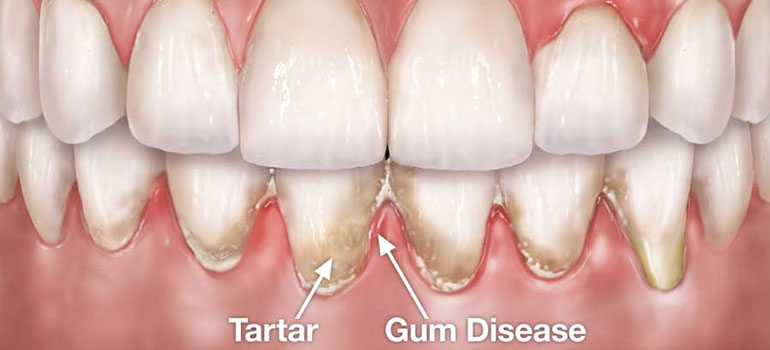
Your dentist has recommended that you see a periodontist, a dental specialist who treats periodontal disease. Periodontal disease is a bacterial infection that infects the gum tissue causing inflammation, redness, swelling and loss of bone around the teeth. It can affect one tooth or many. The National Institute of Health reports that 80 percent of adults in the United States have some form of periodontal disease.
How did I get Periodontal Disease?
Periodontal disease begins with bacteria present in the mouth attaching to the teeth. The bacteria collect and multiply, forming a biofilm called dental plaque. If this plaque is left on the teeth, the adjacent gingival tissues can become inflamed, resulting in the development of gingivitis, an early form of gum disease. Daily flossing and twice-daily brushing with a toothpaste that fights bacteria can help prevent gingivitis. Plaque and food debris are removed by oral hygiene practices and thus clean the surface of the teeth and eliminate bacterial plaque at the gum line of the teeth. [It needs to be clear from this section that gingivitis is an early form of gum disease that can lead to periodontitis, a serious form gum disease, if left untreated
However, if plaque and food debris are not removed and oral hygiene practices are not maintained, then gingivitis will get worse and the gum tissue can become more inflamed, bleeding can occur, the area between the tooth and gum tissue can become deepened to form a periodontal pocket and periodontal disease can develop.
A periodontal pocket develops as the plaque bacteria from the biofilm continues to accumulate and moves below the gum line. At this point, home care is not very effective in removing the dental plaque. If it is left untreated by the dentist or dental hygienist, the biofilm will continue to spread below the gum line and infect the inside of the pocket. The bacteria in the plaque produce by-products that cause the adjacent soft and hard tissue to degrade, forming a deeper pocket in the process. This type of advanced periodontal disease can affect the roots of the teeth and they can become infected, too. The teeth may become loose or uncomfortable and the patient will require gum surgery. The patient would be required to have initial therapy to treat diseased periodontal pockets through scaling and root planning. The dental hygienist would utilize an ultrasonic scaling device to remove plaque, tartar and food debris below the gum line and would hand scale the tooth and root surface to make it smooth and disease free. Scaling and root planing can be completed in two to four sessions depending on how much oral disease the patient may have. Thorough oral hygiene procedures would be reviewed with the patient to improve oral care cleaning techniques at home.
1. Gingival Flap Surgery – If pockets are greater than 5 millimeters in depth, the periodontist would conduct this procedure to reduce the periodontal pockets that were noted in a patients chart. Most patients who have been diagnosed with moderate to severe periodontitis would go through this procedure. The periodontist would cut the gum tissue to separate the gum tissue from the teeth, conduct a thorough deep cleaning with an ultrasonic scaling device as well as hand instruments to remove tartar, plaque and biofilm below the pockets.
2.Gingivectomy – This procedure is conducted to remove excess gum tissue that may be overgrown on the teeth to provide a better area to clean the teeth. The periodontist would numb the patients gum tissue and cut and eliminate the extra gum tissue in the mouth
3. Gingivoplasty – This type of gum surgery is used to reshape healthy gum tissue around the teeth to make them look better. If a person has tooth recession where the gum is pushed away from the tooth, a gingivoplasty can be done. A gum graft can be done where the tissue is taken from the roof of the mouth (this is called a graft) and then stitched into place on either side of the tooth that is recessed.
After gum surgery, it is important that the periodontist or dental hygienist inform you how to clean the teeth and gum tissue with a toothbrush and an antimicrobial fluoride toothpaste, floss and antibacterial mouth rinse. Please consult your periodontal specialist or dentist for more information of how to care for your gum tissue and teeth after gum surgery.